The reality of today’s business landscape is that customers are more connected than ever. Fifty-eight percent of consumers and 77% of business buyers say tech has significantly changed their expectations of how companies should interact with them. A majority (70% of consumers/82% of business buyers) also agree tech has made it easier than ever to take their business elsewhere. The influences of connected customers’ expectations are only beginning to unfold. But customer service teams — if they’re agile enough — are particularly well-positioned to meet connected customers’ demands for speed, personalization, and proactivity. Research published in the “Second Annual State of Service” report shows some interesting ways that service teams are shifting to accommodate this new normal. By and large, corporate leaders are realizing customer experience (CX) is a key competitive differentiator (85% of executives with service oversight [e.g., CEOs, service VPs] agree). Eighty percent of them see customer service as the primary vehicle for improving the customer experience.
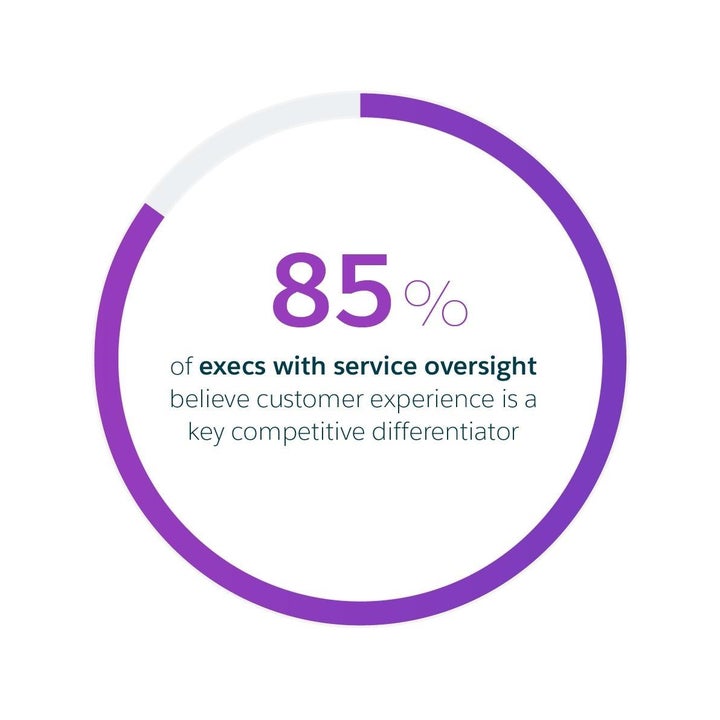
Customer service delivers key competitive differentiation
Service Is Uniquely Positioned to Shape the Customer Experience
The ability to shape the customer experience puts customer service in a place of great opportunity, but also greater scrutiny. Everyone in the business thinks they’re leading the customer experience, but service teams have a unique 360-degree view of the organization’s impact on the customer.
In many ways, service is the voice of the customer — and in fact 60% of service teams say that their interactions with customers are incorporated into product feedback/development cycles . In my experience, service leaders are often skilled diplomats, able to navigate between many internal departments to make improvements on behalf of customers. With service as the nerve center for customer experiences, it’s vital to have a platform with full visibility into sales and marketing (not to mention shared analytics, common customer-centric goals, and measurement capabilities). Forward-thinking service teams are aligning with sales to meet customer needs head-on. This research shows that 63% of service teams have a formal process in place to collaborate with sales. More than two-thirds of service teams (67%) proactively provide sales with intelligence on customer issues and needs.
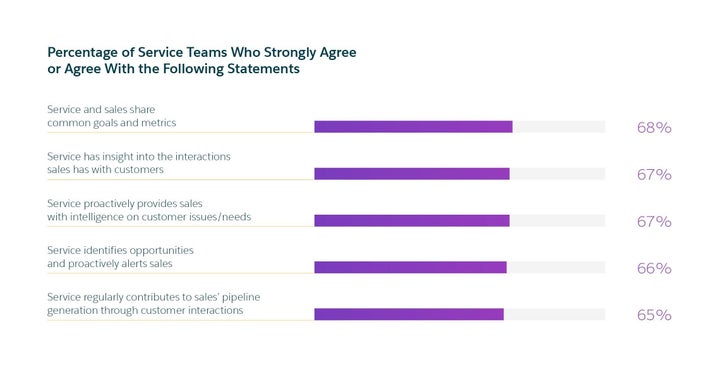
Customer service critical success factors
Service is also a huge part of what constitutes a brand today. Two-thirds (66%) of service teams share common goals and metrics with marketing. Sixty-two percent of service teams collaborate with marketing to manage and respond to social inquiries and issues.

Marketing and Customer Service alignment is key to improving customer experience
Mindset and Metrics Are Evolving to Reflect the CX Focus
How are service teams shaking things up to meet customer expectations? Most say they’re focusing on deeper customer relationships, consistent cross-channel experiences, and personalized service.
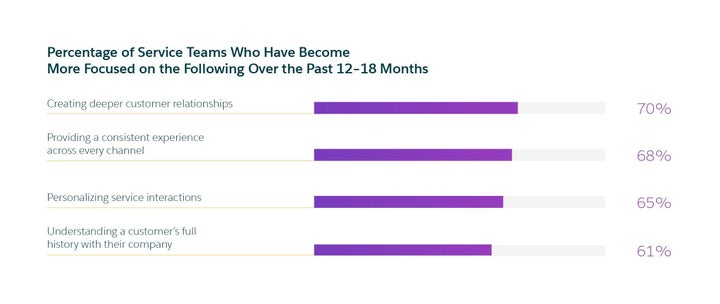
Creating deeper customer relationship is #1 focus area
A change in mindset means changing key performance indicators (KPIs). Service teams anticipate 111% growth in using social promoter score as a KPI.
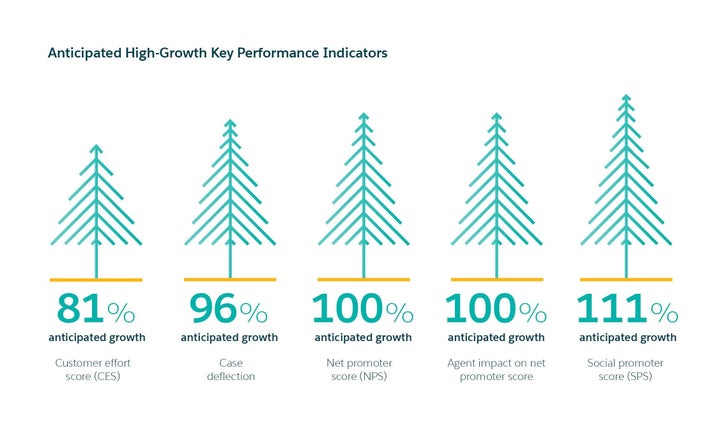
High growth key performance indicators
Connected customer expectations are also having a ripple effect on the number of channels that service agents are covering. In the last year, teams providing service via mobile apps grew by 196% and those offering video support grew by 114%. Sixty-five percent of service teams already deliver service via text/SMS and social platforms. Chatbot technology is also gaining traction, letting companies provide support on a 24/7/365 basis.
Top Teams Are Empowering Service Agents to Embrace the CX Role
“Empowering agents” is a phrase that gets thrown around a lot in the customer service industry, but what’s it really mean? This study points to a few things. The biggest takeaway for me is that top teams are giving agents world-class technology and continuous training — both of which set them up to create a better customer experience.
It’s much easier for companies to adopt a culture of empowerment if there’s accountability and a data-driven set of processes that measure business results and outcomes aimed at delighting customers. Speed is the new currency in the digital service era. As such, it’s not surprising that top service teams are 2.9X more likely than under-performers to excel at promptly solving customer needs with the right information on the first touch. Service teams need systems of engagement, reporting, and intelligence to create transparency, accountability, recognition, and continuous improvements.

Data that leads to actionable insights at the right time, right context is key
Here are a few additional noteworthy findings about the agent experience:
● High-performing service teams are nearly twice as likely (1.7X) as under-performers to agree customer service agents have decision-making power to provide personalized solutions for customers.
● 90% of high-performing service teams say they have the right amount of training to do their job better (versus 48% of under-performers).
● High-performing service teams are 4.1X more likely than under-performers to strongly agree their service agents have the tools and technology to effectively and quickly utilize customer and product information to solve customer issues.
Emerging Tech Helps Provide Smarter, Proactive Service
Half of consumers (51%) expect that, by 2020, companies will anticipate their needs and make relevant suggestions before they initiate contact . Predictive intelligence is the foundation of proactive service — and that’s key to winning customer loyalty. Top service teams are 3.9X more likely than under-performers to say predictive intelligence will have a transformational impact on their customer service by 2020.
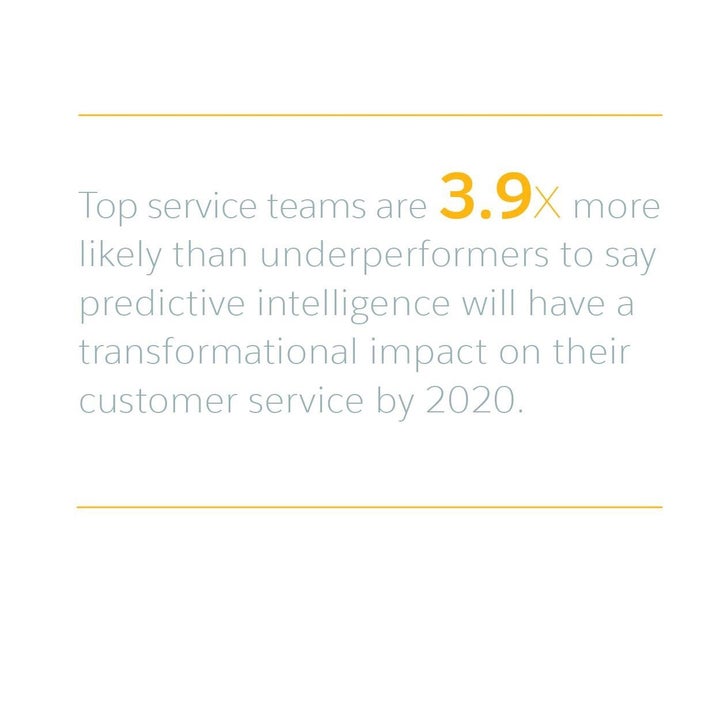
The impact of artificial intelligence and predictive analytics
The ability to address a customer’s issue before they’re even aware of a problem will be a game changer, and Internet of Things (IoT) service applications are nearly endless. For instance, if a service agent had IoT data coming from a customer’s water filtration system, they’d know if the water pressure was too high and could alert the customer before it caused a leak in their home. High-performing service teams are also 4.1X more likely than under-performers to expect a transformational impact from IoT/connected devices by 2020.
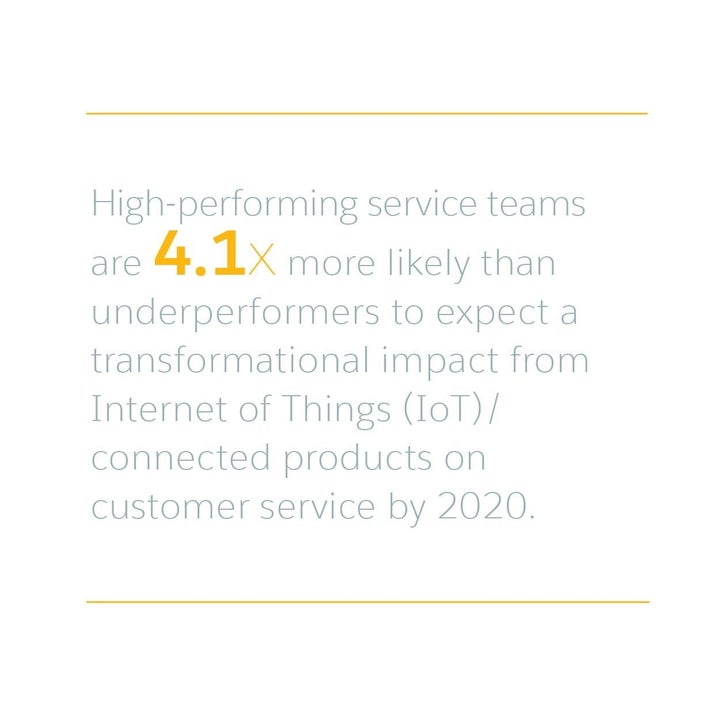
Impact of Internet of Things by 2020
Apart from the IoT potential, artificial intelligence (AI) is already helping companies provide smarter service. Top service teams are 2.2X more likely than under-performers to excel at leveraging AI. Rather than replace human contact, AI enhances the experience by adding human-like intelligence to interactions — for example, machine learning analyzes a caller’s word choice to understand emotions and recommends what an agent should say next.

High performing teams and use of AI
Three Tips to Build a High-Performing Service Team
Whether you’re already a top service team, or you’re looking to become one in 2017, here are a few key things to keep in mind:
● Align with sales and marketing to map out shared goals and metrics focused on the overarching customer experience.
● Consider the technologies you can use to delight connected customers and create a next-gen experience.
● Keep agents engaged with support from leadership, tools that give them a single customer view, and ongoing training.
For more, check out the full “Second Annual State of Service ” report.
